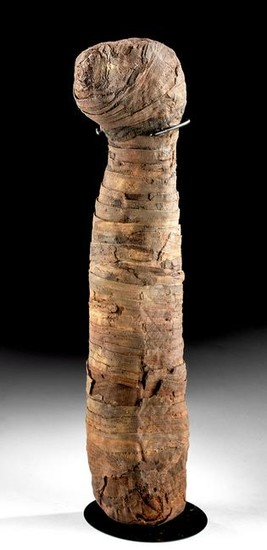Egyptian Late Dynastic Mummified Cat - Votive Offering
Ancient Egypt, Late Dynastic Period, ca. 712 to 332 BCE. A dramatic linen-wrapped mummified cat, its body tightly bundled so that the outline of its skull and the long torso and legs are clearly displayed. This cat was created to evoke Bastet, the cat goddess who represented fertility and motherhood. Thousands of mummified cats and kittens were given as offerings to Bastet at temples in her honor. Beyond the goddess, cats were honored and protected in Egyptian society. Famously, Herodotus wrote that men would protect cats from fire, and that when a cat died, a household would go into mourning as if a human member of the family had died, shaving their eyebrows to signify their loss. Her chief center of worship, Bubastis, became a great city around 1000 BCE, and Herodotus, visiting the city in 450 BCE, described a great festival dedicated to her. Comes in a custom display case. Comes in Size: 3.25" W x 14.95" H (8.3 cm x 38 cm)
Egyptians bred millions of animals, including cats, specifically to be mummified and offered to the gods with a prayer, often at yearly festivals centered around temples devoted to animal cults. A. R. Williams, writing in National Geographic in 2009 ("Animals Everlasting"), described these festivals: "Like county fairs, these great gatherings enlivened religious centers up and down the Nile. Pilgrims arrived by the hundreds of thousands and set up camp. Music and dancing filled the processional route. Merchants sold food, drink, and souvenirs. Priests became salesmen, offering simply wrapped mummies as well as more elaborate ones for people who could spend more - or thought they should. With incense swirling all around, the faithful ended their journey by delivering their chosen mummy to the temple with a prayer."
Provenance: private J.H. collection, Beaverton, Oregon, USA; ex-Bill Jamieson collection, Canada
All items legal to buy/sell under U.S. Statute covering cultural patrimony Code 2600, CHAPTER 14, and are guaranteed to be as described or your money back.
A Certificate of Authenticity will accompany all winning bids.
We ship worldwide to most countries and handle all shipping in-house for your convenience.
#149692 Dimensions: Condition Report: See X-ray to see the body of the cat inside - you can clearly see the skull and other bones. The linen is slightly frayed with deposits and rich patina on the surface.
View it on
Estimate
Time, Location
Auction House
Ancient Egypt, Late Dynastic Period, ca. 712 to 332 BCE. A dramatic linen-wrapped mummified cat, its body tightly bundled so that the outline of its skull and the long torso and legs are clearly displayed. This cat was created to evoke Bastet, the cat goddess who represented fertility and motherhood. Thousands of mummified cats and kittens were given as offerings to Bastet at temples in her honor. Beyond the goddess, cats were honored and protected in Egyptian society. Famously, Herodotus wrote that men would protect cats from fire, and that when a cat died, a household would go into mourning as if a human member of the family had died, shaving their eyebrows to signify their loss. Her chief center of worship, Bubastis, became a great city around 1000 BCE, and Herodotus, visiting the city in 450 BCE, described a great festival dedicated to her. Comes in a custom display case. Comes in Size: 3.25" W x 14.95" H (8.3 cm x 38 cm)
Egyptians bred millions of animals, including cats, specifically to be mummified and offered to the gods with a prayer, often at yearly festivals centered around temples devoted to animal cults. A. R. Williams, writing in National Geographic in 2009 ("Animals Everlasting"), described these festivals: "Like county fairs, these great gatherings enlivened religious centers up and down the Nile. Pilgrims arrived by the hundreds of thousands and set up camp. Music and dancing filled the processional route. Merchants sold food, drink, and souvenirs. Priests became salesmen, offering simply wrapped mummies as well as more elaborate ones for people who could spend more - or thought they should. With incense swirling all around, the faithful ended their journey by delivering their chosen mummy to the temple with a prayer."
Provenance: private J.H. collection, Beaverton, Oregon, USA; ex-Bill Jamieson collection, Canada
All items legal to buy/sell under U.S. Statute covering cultural patrimony Code 2600, CHAPTER 14, and are guaranteed to be as described or your money back.
A Certificate of Authenticity will accompany all winning bids.
We ship worldwide to most countries and handle all shipping in-house for your convenience.
#149692 Dimensions: Condition Report: See X-ray to see the body of the cat inside - you can clearly see the skull and other bones. The linen is slightly frayed with deposits and rich patina on the surface.



